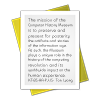Title
Saltzer, Jerome H. "Jerry" interviewCatalog Number
102717242Type
DocumentDescription
Contributed by James Pelekey:Jerome Howard “Jerry” Saltzer received his ScD in Electrical Engineering from MIT in 1966; his Doctoral Advisor was Fernando J. Corbato. He then joined MIT’s faculty as a member of the Department of Electrical Engineering and Computer Science. In addition to teaching, he was able to continue his research in timesharing. By the early 1970’s, he became one of the team leaders for the Multics operating system Project. Later in the 1970’s, the research group he led, known as the Computer Systems Research group, made key contributions in local area networking. Those contributions are what motivated this interview, and those of two of his team members: David Clark and Ken Pogran, as well as of a key consultant: Howard Salwen of Proteon. In 1975, when MIT’s Laboratory of Computer Science (LCS) became interested in local area networking, ARPA encouraged them to investigate the unique token ring technology being developed by David Farber (also interviewed as part of this Collection of Interviews) and his team at the University of California at Irvine. Pogran would visit them and on his return to MIT, the LCS team decided to import Farber’s token ring local area network. That story is retold in a number of interviews. The second major contribution was Clark’s TCP/IP port to the IBM PC. Then in 1977, Saltzer took a sabbatical and went to work for IBM. At the time, IBM was also exploring token ring in its Zurich Laboratory. Compelling questions in this reconstruction will be how and why did IBM elect to use token ring for its local area networks. In 1984, Saltzer’s involvement in local area networking ended when he became Technical Director of MIT’s Project Athena.
Interviewing Professor Saltzer was an unexpected joy. Whereas I had been forewarned that he might be a challenge to interview, difficult to read and prone to short answers, I found him anything but. He reflects on a variety of technologies – such as personal computing and TCP/IP protocols – and the factors that lead some technologies to succeed, such as the confluence of strong researchers and problems that are amenable to breakthroughs, and others to fail. Unfortunately, I did not get definitive answers to my questions of how IBM settled on token ring, but it seems clear that the path of technology transfer did progress in part from MIT to IBM.
Date
1988-03-07Contributor
| Pelkey, James L., Interviewer |
| Saltzer, Jerome Howard, Interviewee |
Publisher
Computer History MuseumPlace of Publication
Cambridge, MAExtent
39 p.Format
PDFCategory
TranscriptionSubject
MIT LCS; Chaosnet; Ethernet; token ring; local area networking; Proteon; IBM Zurich Laboratories; Bob Metcalfe; David Farber; TCP/IP; ARPA; IBM PCCollection Title
James L. Pelkey collection : history of computer communicationsCredit
Gift of James PelkeyLot Number
X5671.2010Related Records
| 102746648 | James L. Pelkey collection : history of computer communications |


